Gabriel Hemery's Blog: Gabriel Hemery, page 8
January 31, 2022
RFS Book Club
I had the pleasure recently of talking with members of the Royal Forestry Society’s new book club. You can watch the full talk below.
It was wonderful to see some familiar faces, and to have made many new (virtual) acquaintances.
I am grateful to the RFS for sharing a recording of the evening talk so that I can embed it here.
I talked about the origins of my book The New Sylva and my collaboration with co-author and artist Sarah Simblet. I also introduced my latest book project The Forest Guide (Scotland), which is due to be published in 2023.
Find out more about the Royal Forestry Society.
The post RFS Book Club appeared first on Gabriel Hemery.
January 8, 2022
Beta-Readers Wanted
Are you a fan of fantasy fiction? Would you be interested in reading and commenting on a draft of my next novel?
In late 2021, I completed drafting my next novel. I’m now looking for fans of ‘low fantasy’ who in return for a free copy, would be willing to read the book and provide an honest internal (i.e. non-public) review and comments directly to me. This is a chance for readers to have a real impact on the shape and content of the final novel which will be published later this year.
I would expect beta-readers to be keen readers of fiction, especially fantasy. Examples include: The Name of the Wind (Rothfuss) , The Lord of the Rings (Tolkein), A Wizard of Earthsea (Le Guinn), and so on. You will need to be prepared to read the novel carefully, perhaps making notes as you do so. You will be expected to offer constructive criticism. An online form will be provided to help you provide feedback.
If you are interested in taking part, please complete a simple form I’ve created and I will be in touch. The book will be shared electronically, so you will need a device like a Kindle or ipad to take part.
click the button above or use the embedded form below
Loading…The post Beta-Readers Wanted appeared first on Gabriel Hemery.
January 2, 2022
England’s National Parks 2.0
England’s National Parks are no longer fit for purpose. Even before the climate emergency, their lack of naturalness is impeding attempts to halt declining biodiversity, but now there is a real urgency to renew thinking towards our 10 National Parks. We need a new version for our National Parks; a version 2.0.
England’s National Parks are an embarrassment for anyone who cares for nature, a sign of our failure to protect the natural world, and a sad corroboration of culture defeating strategy
 My vision for the Erme Valley around Piles Copse, Dartmoor. Sketch by Gabriel Hemery
My vision for the Erme Valley around Piles Copse, Dartmoor. Sketch by Gabriel HemeryThe National Parks of England include iconic landscapes, loved by everyone for their beauty. They are also working landscapes, managed by farmers and estate owners for raising livestock or for shooting. Sadly, many of these traditional approaches to land management are becoming increasingly outdated, and have led directly to land which is seriously depleted of nature. Our national parks should be the jewels in our crown, but let’s not beat about the bush here, overall they are an embarrassment for anyone who cares for nature, a sign of our failure to protect the natural world, and a sad corroboration of culture defeating strategy. I say overall, as there are many good examples of valuable work being done, so my comment is a strategic one, aimed at National Park Authorities and central government. Now you can take action, by signing a petition (see below).
Why do we need wilder National Parks?Nature is badly depleted in our national parks. In England’s national parks, three-quarters of Sites of Special Scientific Interest are in a poor condition and often in a worse state than elsewhere.Many National Parks have less tree cover than nearby major cities (see below).The UK is ranked 189th out of 218 countries for its quality of nature.56% of our species are in decline and 15% threatened with extinction.England’s national parks are extremely valuable, but the threats of declining nature and the climate emergency are outpacing us.Rather than proposing new national parks, Government’s priority should be rewilding those we already have (even if only in name, not in nature).
Whilst most look wild and natural, they are not. We have become conditioned to thinking that the barren hills and big vistas are natural – they are not. We have become used to seeing isolated contorted trees struggling to survive on hillsides – these are not a sign a wilderness, but a sign of declining naturalness. I know that I’m not alone in holding these views. For instance, a survey conducted in 2016 showed that most people wanted our national parks to provide ‘better conservation of wildlife’, followed by a wish to ‘make them wilder’.
Tree Cover in England’s National ParksMost people want our national parks to provide ‘better conservation of wildlife’, followed by a wish to ‘make them wilder’.
Campaign for National Parks Survey, 2016
I’ve spoken out many times in this blog and in my published writing about the sorry state of our National Parks when it comes to tree cover. Britain (and England) has one of the lowest area of trees for any country in Europe (see Tree Cover in Europe). In the Arboreal (Little Toller, 2016) collection of tree stories, my short story Don’t Look Back struck an optimistic note, imagining a time in the future when the barren slopes of Dartmoor are covered in trees. In my short story Westmorland-Upon-Sea (Tall Trees Short Stories: Vol20, 2020), I included a poem titled Wilding.
WildingGabriel HemeryI wondered, lonely as a thorn
That clings on high o'er cliff and hill,
When upon an early morn,
I spied a flock of those who kill;
Across the prairie, deprived of trees,
Roving and slaying in the breeze.
Continuous as the former stars
That twinkled once, before the glow,
They stretched in never-ending scars
From mountain peak to flat plateau:
Ten hundred saw I at a glance,
Tossing their heads in deathly dance.
The waves below me crashed; but they
Ignored the sea and wind with glee:
A tree like me can only sway,
In such a careless company:
I gazed—and gazed—with troubled thought
What ruin humankind had wrought.
For oft, when on my crag I cling
In hope or in a desperate mood,
I ponder if man, might soon bring
An end to my bare solitude;
And I beg to that creator,
For the wilding of our nature.
From Westmorland-Upon-Sea, Tall Trees Short Stories: Vol20. Wood Wide Works (2020)
Investigative work by Friends of the Earth, using a ‘Woodland Opportunity Tool’, has revealed some powerful metrics in the form of data and mapping analyses to emphasise what is obvious to anyone who can ‘read’ the true nature of our national parks. I find it nothing short of shocking that many of our National Parks have less tree cover than their nearby major cities. For instance, there is less woodland cover in the Yorkshire Dales than in London, less in the Peak District than in Leeds, and less in the Lake District than in Sheffield.
What is powerful about these data, are how these estimates of increased tree cover are conservative. Important landscapes and protected habitats are excluded from the estimates. Other than the Broads, New Forest, and South Downs, tree cover could be increased by at least 150% across every National Park. Government could also take a lead, because although most land in our National Parks is privately owned (unlike National Parks in many other parts of the world), it does own on average, 10% of the land. Rather than proposing new national parks, I believe Government’s priority should be rewilding those what we already have in place, in name if not in nature.
National ParkExisting Woodland Cover (%)Potential Woodland Cover Increase (%)Broads1213Dartmoor1231Exmoor1451Lake District1330New Forest3746North York Moors2241Northumberland2337Peak District843South Downs2329Yorkshire Dales428AVERAGE16.834.9Source: Woodland Opportunity Tool, Friends of the Earth.The analysis of potential woodland cover excluded Priority Habitats, Special Protection Areas, Special Areas of Conservation, RAMSAR Sites, Sites of Special Scientific Interest, National Nature Reserves, Local Nature Reserves, Moorland Line, and OS Green Space.
Take Action – Sign the PetitionA campaign by Rewilding Britain has been launched recently, supported by Wildlife Link and Friends of the Earth.
Read more and Sign the petitionHelp us protect our loved but declining wildlifeAbsorb carbon and help fight the climate crisisReduce flooding and improve water qualityAllow people to reconnect with nature-rich, wild placesCreate much-needed habitats for declining plants, birds, mammals and insectsOffer new opportunities for communities and local economies, including nature-friendly farming, forestry, eco-tourism and recreationLead the way to a wilder Britain by inspiring rewilding and nature recovery nationwideThe post England’s National Parks 2.0 appeared first on Gabriel Hemery.
December 6, 2021
The New Sylva 2021
The new compact hardback version of The New Sylva has been well received by readers this autumn.
Many readers have commented that they can’t believe what good value it is (£30 RRP) for a book of its size and production quality. It makes the original version (2014) appear large in comparison, but the designers of the 2021 compact edition have managed to cleverly redesign it without any significant loss of impact. While the glorious drawings are 30% smaller and the hardback cover is a little less luxurious, it still feels and looks like a quality book.
If you would still prefer to get your hands on the original edition, don’t despair, I’m told it will be republished in 2022. I’ll be announcing more details on this in the new year.
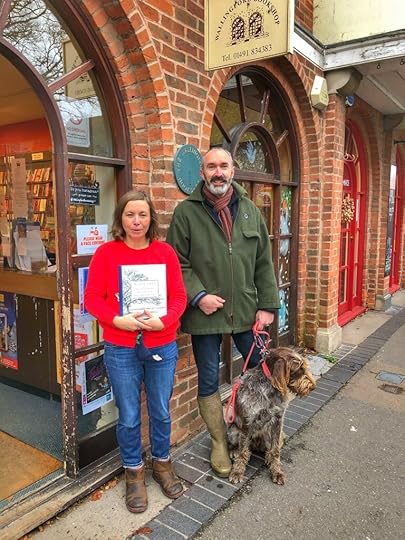
This weekend I visited my local bookshop in Wallingford, Oxfordshire, to sign a few copies of The New Sylva (2021) to help them make the most of the Christmas sales opportunity. My young Italian Spinone Alba enjoyed the attention she received from Helen and Ali. See: www.wallingfordbookshop.co.uk
If you can’t visit your own local bookshop in person, why not take a look at Bookshop which allows you to shop online for books and support your local bookshop at the same time. What’s not to like!
 My books on Bookshop
My books on BookshopThe post The New Sylva 2021 appeared first on Gabriel Hemery.
December 5, 2021
November Book Giveaway
Congratulations to Jacqueline from Taunton, England, for being the first name ‘out of the hat’ for my November prize draw. Jacqueline wins a signed copy of Stories of Trees, Woods, and the Forest.

My November 2021 book giveaway was a free signed copy of this wonderful anthology of short stories, featuring one of my own: The Man Who Harvested Trees (and Gifted Life).
Didn’t win? Don’t despair, I’ve another great giveaway for December. A selection of five photo greeting cards featuring my tree and wildlife photography. Make sure you have signed up to my enews by 31st December for a chance to win.
The post November Book Giveaway appeared first on Gabriel Hemery.
November 25, 2021
Martin Wood 1927-2021
I am greatly saddened by the death of my friend, colleague, and patron, Sir Martin Wood aged 94 years.
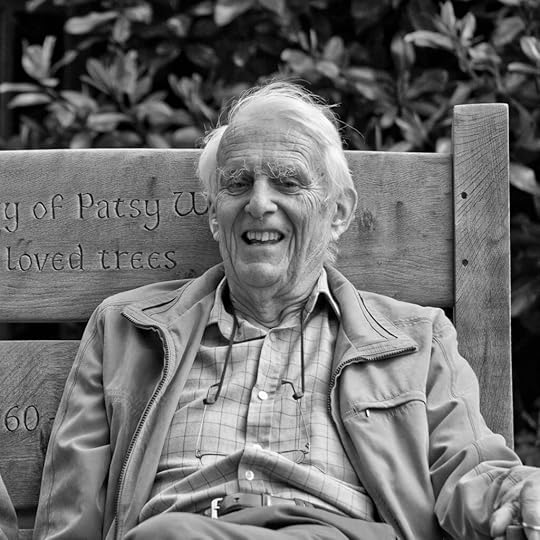 Martin Wood, 2015
Martin Wood, 2015Sir Martin Wood FRS was a visionary engineer, passionate conservationist, and a prolific philanthropist, who had an incalculable influence on my professional and personal life.
I first met Martin when, fresh from university, I started a one-year apprenticeship working with his first charity, the Northmoor Trust. A shared passion for trees and a keen interest in science brought us close together, and when Martin and his wife Audrey decided to gift the charity 80ha of farmland, he turned to me, asking whether I would be prepared to work for a few weeks to ‘come up with a plan’ for a new wood. Thirteen years later, we were still working on that plan together! The result was the vision for Paradise Wood, owned and managed by the Earth Trust, undertaking forestry research focussing on hardwood trees and the planting of tens of thousands of trees in South Oxfordshire and at other field trial sites across Britain.
Martin encouraged me to continue learning and developing my scientific interest in trees, which led ultimately to me completing my DPhil at Oxford University. Together, we frequently met with landowners and scientists seeking to improve knowledge and science surrounding hardwood forestry. We were both heavily involved in the formative years of an organisation that later became a separate charity, the Future Trees Trust.
I will never forget the day that I bumped into Martin when, as a young forester I had spent a hard winter’s day planting another 400 trees or so in the sticky soil of the young Paradise Wood. I was plastered in mud, cold, sodden, and exhausted. He asked how I was, and my response was something along the lines of it being a ‘miserable wet day’. The outcome was a playful (only just!) thump on the arm and the retort:
There’s no such thing as a miserable day – this is perfect weather for trees!
Martin Wood
On another memorable occasion, we visited the unusual box woods found on the Prime Minister’s country estate at Chequers. Together, we dug up some 2,000 young box seedlings from an area of natural regeneration (with permission!) to translocate them to an experimental site.
After I left the Northmoor Trust (now Earth Trust), we kept in touch. In 2006, we had an important conversation. ‘Gabriel, what is the state of British forestry?’ asked Martin at some event we fortuitously found ourselves attending together. I described the huge volume of timber imports into Britain, the languishing unmanaged woodlands unfit for society or nature, and the wasteful creation of ‘green fluff’ under so-called woodland creation schemes. Ultimately, this led to familiar offer: if he were to fund a job for me, would I be prepared to put together some thoughts and information, and ‘come up with a plan’? This was another rare opportunity, not only to do what I cared passionately about, but to work closely with Martin again. I seized it enthusiastically. On my first day at the office, fresh from a family holiday in France, I found a handwritten note waiting for me on my empty desk:
“Bonjour Gabriel – greetings, a great day – we’re going to change the face of forestry in the British Isles!”
Martin Wood, 8th May 2006
No quote could better capture Martin’s personal touch, nor his ambition and verve for life.
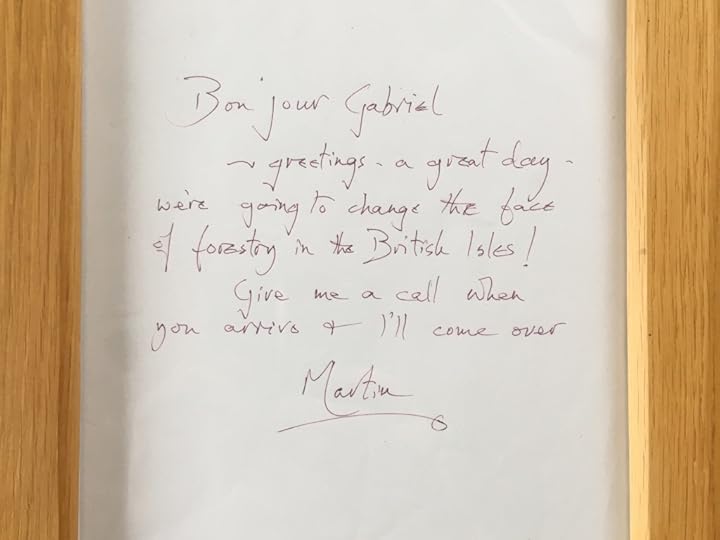 A letter from Martin Wood, May 2006
A letter from Martin Wood, May 2006Three years later, in 2009, came the formal constitution of a new charity that Martin and I co-founded: Sylva Foundation – a charity aiming to revive Britain’s wood culture. We worked closely together, setting out the vision for this new organisation, and I think also in retrospect, its collaborative ethos and ‘can-do’ attitude.
Martin was an enthusiastic supporter of innovation, including in the charity’s use of information technology, even though its possibilities were very new to us all. He never suffered fools lightly, but was always courteous and supportive. Anyone sharing airy thoughts or using pompously technical language was always challenged to explain better, using plain English.
 Sir Martin Wood with Gabriel Hemery and Sarah Simblet, co-authors of The New Sylva, in April 2014
Sir Martin Wood with Gabriel Hemery and Sarah Simblet, co-authors of The New Sylva, in April 2014In 2012, I proposed to Sylva’s trustees the idea of a book to celebrate the 350th anniversary of John Evelyn’s landmark book, Sylva. Martin was among the most enthusiastic supporters of the idea. It was a great privilege that he agreed to write an Introductory Note to The New Sylva, published by Bloomsbury in 2014.
… a modern-day clarion call for the creation of a new wood culture that may help to ensure a sustainable and enjoyable future for us all.
Martin Wood, Introductory Note to The New Sylva (Bloomsbury Publishing, 2014)
In recent years, Martin’s health declined, but it was always a privilege to welcome Martin and Audrey to see our progress in developing the Sylva Wood Centre, or to visit their home and talk strategy over a cup of tea.
While Martin ultimately became a Patron of Sylva Foundation, at a personal level he was my long-term patron, investing his trust and passion for the environment through our relationship. In another sense, and with a touch of irony, Martin Wood was my guardian angel.
Spirit, genie or djinnRelease you possession
From the smokeless fire
Now he holds your soul
Safe among the sand
Where nature attracts
The greatest kind
From: The Martin Tree, Tall Trees Short Stories Vol21 (Wood Wide Works, 2021)
The post Martin Wood 1927-2021 appeared first on Gabriel Hemery.
November 21, 2021
Moon Glade
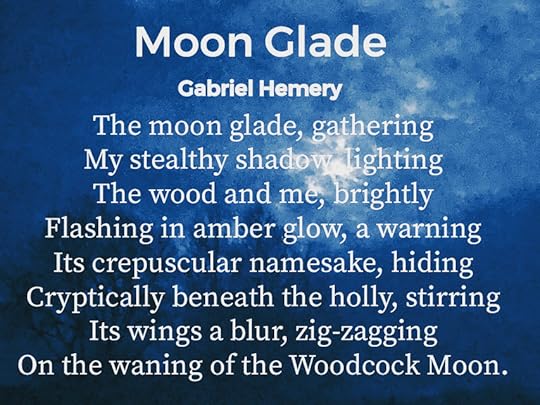 The moon glade, gatheringMy stealthy shadow, lightingThe wood and me, brightlyFlashing in amber glow, a warningIts crepuscular namesake, hidingCryptically beneath the holly, stirringIts wings a blur, zig-zaggingOn the waning of the Woodcock Moon.
The moon glade, gatheringMy stealthy shadow, lightingThe wood and me, brightlyFlashing in amber glow, a warningIts crepuscular namesake, hidingCryptically beneath the holly, stirringIts wings a blur, zig-zaggingOn the waning of the Woodcock Moon. Gabriel Hemery, November 2021
See also: Woodcock Moon
The post Moon Glade appeared first on Gabriel Hemery.
November 15, 2021
When I Fall
Gabriel Hemery, November 2021
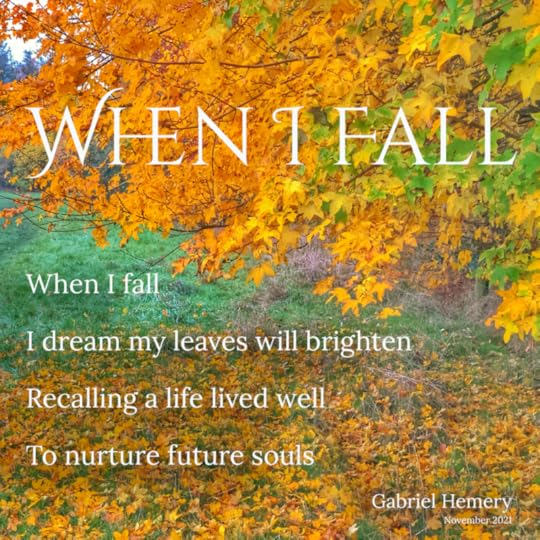 When I Fall
When I FallThe post When I Fall appeared first on Gabriel Hemery.
November 1, 2021
Recipient of the Roger Deakin Award
I have been honoured with the Roger Deakin Award from the Society of Authors in support of my writing.
Writing a book – at least the types of books that I write – are rarely worked on with a view to earning money. Other motives hold more sway, and among those for me at least are my wish to share a passion for trees, and to help people connect with nature.
With my latest book, which is a guide to Scotland’s forests, the advance from the publishers goes only a small way towards covering expenses incurred in travel and subsistence during the extensive field work, investment in capital equipment (e.g. a new camera lens or outdoor gear), let alone my time spent research and writing. This is not a criticism of my own publishers Bloomsbury Wildlife, or indeed any other, it is simply the reality of the very tight margins for most non-fiction books.
Beyond the book deal there are few options for authors seeking additional financial support. Individuals are rarely eligible to apply to trusts and foundations. From time to time, national arts councils issue awards, but these can be very specific and quite limiting. In my own case for example, I was ineligible to apply to Creative Scotland because I live outside Scotland.
 The Society of Authors
The Society of AuthorsWhen I joined The Society of Authors (SOA), I paid little attention to the fact that it offered financial bursaries and awards to its members, because my motivation was to become part of a community of writers. Their existence resonated with me later when I read an article about them in one of the SOA’s quarterly member magazines. I barely dared to allow any hope to surface as I knew competition would be fierce, but nevertheless began the process of preparing an application.
During my research of what to include in the application, I discovered that part of the funds to support authors had come from the estate of the late great nature writer Roger Deakin. I had the great privilege of meeting Roger when I was a young researcher, and indeed had helped him prepare for his travels to Kyrgyzstan to hunt walnuts – Read More. So it seemed that perhaps serendipity might play a part, and buoyed by this thought, I submitted my application to the SOA.
It is hard to describe the feeling on receiving the news last week – aptly enough while I was on a remote mountainside in the Orkneys completing the book research – that I am the recipient of the 2021 Roger Deakin Award by The Society of Authors. I am honoured and humbled, and of course hugely grateful, for this award. The Roger Deakin Award means a great deal to me, well beyond the financial award itself.
 Fieldwork in the Orkney Isles
Fieldwork in the Orkney Isles“The Roger Deakin Award means a great deal to me, well beyond the financial award itself.”
Gabriel Hemery
I am deeply indebted to The Society of Authors for its generous support. I urge all writers in my position to become a member, and if you ever need financial support you may be equally fortunate and be eligible to apply for an award.
The post Recipient of the Roger Deakin Award appeared first on Gabriel Hemery.
October 26, 2021
The Miracle of Berriedale
Leave behind the oystercatchers and curlew in the sheltered bay, and climb steadily. Tread boldly past the red-throated diver on Sandy Loch, doff your hat to the merlin darting through the moorland glen, and keep going west. Most people climbing the Old Postman’s Path across the Isle of Hoy, will only have the Old Man in their sights. But you have another ancient thing to see, another miracle of the natural world, and this one is living. Few will notice it under the towering crags of Grut Fea, but look carefully with a knowing eye, and the miracle of Berriedale Wood will call to you. This is a very special wood – Britain’s most northerly natural woodland.
 The Walker’s Route to Rackwick, follows the Old Postman’s Path
The Walker’s Route to Rackwick, follows the Old Postman’s PathIts trees fill the steep-sided burn, almost as if a plasterer filled in the bends and crevices of the Berriedale Burn with a ‘special mix’. None of the trees dare poke their heads about its sheltered sides, as they would be soon tattered by Atlantic westerlies.
There is a fine view from the path that heads to Rackwick, of both this wood and the fragments of another natural wood just to the north. This is a close as most should attempt to get, for deep bog, plus waist-high heather and bracken make gaining access to Berriedale Wood a major undertaking.
almost as if a plasterer filled in the bends and crevices of the Berriedale Burn with a ‘special mix’
Inside the wood, birch and rowan cling to life. Ropes and twines of honeysuckle twist round every tree, acting as nature’s guy-lines. Fungi, ferns, and wood rush clad the woodland floor, and flocks of finches and buntings flit from tree to tree, while a wren is always on hand to issue a warning.
At the top of the wood are magnificent falls, but this special place is best left untrodden.
It is a 4.5km walk from the ferry to the point on the track opposite the site. The first half of that is all uphill on tarmac roads. After that, follow the trail through the glen. The track is rough and often very wet. This is an exposed route, and you should be well prepared for hill walking. Location: 58.8880842, -3.3301036
The Hoy Nature Reserve is owned and managed by the RSPB.Berriedale Wood will be one of several hundred sites included in The Forest Guide: Scotland by Gabriel Hemery, published in 2023 by Bloomsbury Wildlife. See: gabhem.com/forest-guide
If you have a favourite wood, use the link above and discover how you can propose a site for inclusion.
The post The Miracle of Berriedale appeared first on Gabriel Hemery.
Gabriel Hemery
I’m a silvologist—or forest scientist—and a published author. I’m also a keen amateur photographer with a passion for tr Welcome to my silvological blog featuring the study of trees, forests and woods.
I’m a silvologist—or forest scientist—and a published author. I’m also a keen amateur photographer with a passion for trees. ...more
- Gabriel Hemery's profile
- 14 followers



